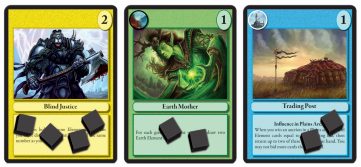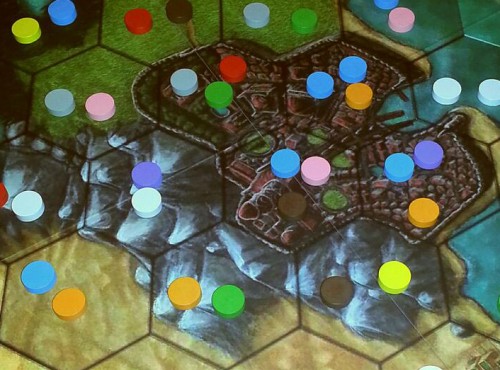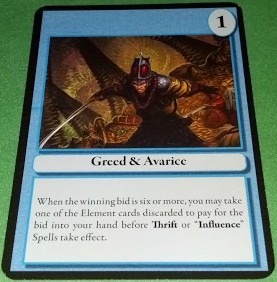Wizards are a peculiar lot. At best, they embody the fantasy realm’s equivalent of a walking arcane library. They go where they are needed, dispensing wisdom, insight, mentoring, and even justice. They both honor and eschew customs, as they are of the world they belong to, but they share with you that glimmer of hidden worlds that only they can see. At worst, their arrogance and dismissal of others as beneath them leaves them grumpy, aloof, or down right dangerous.
Whatever the case may be, though, they’re always up to something. Tinkering, scheming, learning, searching. Whether it’s Merlin or Dumbledore, Gandalf or Ged, it’s best for us lay folk to be wary of them and their “quests”. Lest we get eaten by dragons…
The Premise
The land’s wizarding population has recently figured out how to create the fabled Elixir of Life. To achieve it, however, will require ingredients from across the realm. With limited resources, the players must traverse the land to acquire the right combination of these materials. Players compete with fellow wizards using their arsenal of spells and control of the elements in order to be the first one to complete their potion, thus proving who the greatest wizard is.
The Rules
Setup in Wizard’s Brew is pretty straightforward. Each player receives a Cauldron placard, one card from each of the four Element decks, and 10 Energy cubes, which will be used to power Spells. Each player also receives two Spells to start the game. Spells are powerful but temporary abilities that will let players gain Element resources, affect the acquisition of potion ingredients, or mildly interfere with other players. Players secretly allocate some or all of their finite Energy cubes to those initial Spells, which determines how many rounds they will stay in effect. Unspent Energy cubes will be used to subsequently purchase new Spells.
On the main board, Ingredient tokens are placed randomly in each space, as is one Landmark token. The starting player is also determined randomly, given the Wizard marker, and places the Horse marker in the middle of the board.
The game is played out over a series of rounds, broken down into four phases: Spell, Element, Ingredient, and Energy. Each phase starts with the person controlling the Wizard marker at that time. In the Spell phase, a new Spell is revealed from the top of the deck and is auctioned off. Using Energy cubes, players, in turn order, have one chance to either raise the previous bid or pass. The winning player gets control of that Spell, putting the Energy cubes bid on it and getting the Wizard marker. This process is repeated until new Spells equal to the number of players have been dispensed, or until all players pass on a spell.
In the Element phase, players draw Element cards equal to the number and types of Element symbols present on their spells.
 Most of the time spent in Wizard’s Brew happens during the Ingredient phase, whereby players are jaunting around the map gathering the needed elixir components. The phase starts by the player rolling the provided die, determining how many turns the phase will have (between three and six). Next, they move the Horse marker to an adjacent location. (It is a magical Horse so it skips empty spaces).
Most of the time spent in Wizard’s Brew happens during the Ingredient phase, whereby players are jaunting around the map gathering the needed elixir components. The phase starts by the player rolling the provided die, determining how many turns the phase will have (between three and six). Next, they move the Horse marker to an adjacent location. (It is a magical Horse so it skips empty spaces).
Players then use their Element cards to bid on the ability to take an ingredient from that spot. The Landmark token specifies which Element can be used for that space. Like the Spell phase, players must either raise the bid or pass, and if all players pass, the phase immediately ends. Unlike the Spell phase, however, players have the option to re-raise their bid. The winner discards the Element cards bid and chooses which ingredient they wish to add to their Cauldron. Additionally, they receive the Wizard marker. If there are still turns left in the phase, they will move the Horse to a new location to bid anew.
In the Energy phase, players with special yellow Spells can opt to use them. Then, players remove Energy cubes from Spells equal to the Spell’s power (either one or two), returning them to their available pools. Any Spell with no Energy on it is discarded.
Rounds continue until a someone reaches the number of ingredients required, which is dependent on the number of players. For example, in 4-player game, players either need seven different colored ingredients, or eight of any kind. Once that happens, that player gulps down their potion and is immediately the winner. Everyone else must abandon their quest in disgrace.
Just Don’t Call It A Philosopher’s Stone
 In 1997, an unknown British author released a book that would become a worldwide phenomenon. This, of course, was J.K. Rowling’s Harry Potter and the Philosopher’s Stone. However, when it was released in the US in 1998, the publishers renamed it the Sorcerer’s Stone. They did this because they didn’t think that Americans were familiar enough with the concept of the Philosopher’s Stone to properly reflect what the book would be about. So they went with something that sounded a lot more magic-y. Another such example was 1989’s James Bond movie License to Kill. Originally titled License Revoked, it was changed in post-production because the producers felt that many Americans wouldn’t know what the word ‘revoked’ meant.
In 1997, an unknown British author released a book that would become a worldwide phenomenon. This, of course, was J.K. Rowling’s Harry Potter and the Philosopher’s Stone. However, when it was released in the US in 1998, the publishers renamed it the Sorcerer’s Stone. They did this because they didn’t think that Americans were familiar enough with the concept of the Philosopher’s Stone to properly reflect what the book would be about. So they went with something that sounded a lot more magic-y. Another such example was 1989’s James Bond movie License to Kill. Originally titled License Revoked, it was changed in post-production because the producers felt that many Americans wouldn’t know what the word ‘revoked’ meant.
This tactic is done more than you would think when it comes to distributing things on a worldwide basis. Usually it’s done because topics may be culturally or geographically relevant in one area but bear no significance in another. Or they just assume the audience won’t understand.
That’s sort of what transpires in Wizard’s Brew, at least from a flavor perspective. You are alchemists trying to brew the Elixir of Life, a thematic plot that would lend nicely to use of the Philosopher’s Stone. But it is never mentioned. It is hardly the only sin of omission, evoking questions such as, “If we are competing to finish the potion, why are we all traveling together?”, and, “What ingredients are we actually collecting? All I see is ingredient Purple.”
Granted, these questions don’t affect the mechanics of the game at all, but you can bet that your Immersionist friends will take notice of such thematic vagaries. They’ll likely also mention that this game has issues with the Stroop Test: there are Green Element cards, Green Spells, and Green Ingredients, but they are all unrelated. We’re a bit more forgiving with that, since there’s only so many basic colors to work with, but we agree it can get a tad confusing at times.
An area where it is less acceptable is with the rules. The rulebook provided is short, thorough and does a good job of explaining most things. So it’s a bit odd to see important Spell-related material – arguably the only somewhat complex part of the game – left out. It has to be inferred that bold text in a Spell is actually referring to another Spell, and Spells that reference “Influence” are actually talking about a subset of Spells that provide bonuses. Subsequent playthroughs negate this issue, but it makes the first time it’s played more difficult. This seems to be more of an oversight than anything else given the decent rules otherwise, but not knowing these things evokes more of the “Why am I doing XYZ?” feeling.
All Aboard the Immortality Express
Wizard’s Brew’s main focus is on engaging players with each other as it goes about its business, even if it may seem a bit counterintuitive on some levels. As players venture around the map via the Horse marker (whom we decreed that he shall forever be known as Bill the Pony), they have to play a mild tug of war in order to affect the direction players go. This relies on being able to outbid one another for control of the reigns more than directly affecting another player’s actions. Sorry Strikers, but there is only a handful of Spells that can muck with another player. If you are looking for a confrontational game, this is not it.
 Other groups are delivered similar cautions. The flow of Wizard’s Brew is pretty linear, and Bill the Pony moves it along at a progressive-but-leisurely pace. This likely won’t bode well for Daredevils, who would be looking for non-existent alternative paths to victory. Architects won’t mind the congenial tone aspect of the game – it often feels like a gentleman’s wager among wizards – but there is little for them to build up or accumulate. Sure, you are after elixir ingredients, but so is everyone else. Moreover, you have to pitch your Element cards in bidding to acquire it. Trading one resource for another, even if it’s advancing towards the win, is not their preference.
Other groups are delivered similar cautions. The flow of Wizard’s Brew is pretty linear, and Bill the Pony moves it along at a progressive-but-leisurely pace. This likely won’t bode well for Daredevils, who would be looking for non-existent alternative paths to victory. Architects won’t mind the congenial tone aspect of the game – it often feels like a gentleman’s wager among wizards – but there is little for them to build up or accumulate. Sure, you are after elixir ingredients, but so is everyone else. Moreover, you have to pitch your Element cards in bidding to acquire it. Trading one resource for another, even if it’s advancing towards the win, is not their preference.
For Tacticians, Wizard’s Brew is a bit perplexing in that it wants to offer them more than what is actually available. The right combination of Spells in your arsenal can make for some useful interactions, but it’s hard to plan that since which Spells come up each round are random. There is little room beyond that for them to put their clockwork cunning into action. For players who enjoy light strategic decision-making, the game succeeds plesantly, but for many Tacticians, it won’t be enough.
 The one group that this game will particularly resonate with more than any other are the Socializers. At first glance, it looks like a game not terribly suited for them, but once Wizard’s Brew is underway, that thought dissipates. The game manages to never get too bogged down with complication or drag on too long that a Socializer will lose interest, and it provides choices in a way that never feels intimidating. This shouldn’t be surprising given that Wizard’s Brew was partly designed by Alan Moon, the creator of Ticket to Ride. This is a game in a similar weight-class. Except, instead of trains, you have a Horse, a Cauldron, and a bunch of elixir ingredients to collect.
The one group that this game will particularly resonate with more than any other are the Socializers. At first glance, it looks like a game not terribly suited for them, but once Wizard’s Brew is underway, that thought dissipates. The game manages to never get too bogged down with complication or drag on too long that a Socializer will lose interest, and it provides choices in a way that never feels intimidating. This shouldn’t be surprising given that Wizard’s Brew was partly designed by Alan Moon, the creator of Ticket to Ride. This is a game in a similar weight-class. Except, instead of trains, you have a Horse, a Cauldron, and a bunch of elixir ingredients to collect.
The Takeaway
At the end of the day, what’s been whipped up with Wizard’s Brew is a fairly light game with some fun mechanics. For all the nitpicking mentioned, Wizard’s Brew is still a decent bit of enjoyment. It’s an auction-centric game where you also get to cast spells. (Alas, if only Ebay had similar options.) Its setting is a bit generic, and the premise is a bit thin, but not every game is going to have a verdant backstory and immense world-building lore. Indeed, Wizard’s Brew feels much closer to a corollary to Settlers of Catan – another game that succeeds despite it humble concept.
That said, it shades closer to a Gateway Plus Game than Settlers due to the added complexity Spells can bring to the equation and that there is a little less overall luck involved comparatively. The emphasis on player engagement, the variety of the Spell cards, the random aspects to setup, and the modest play time makes the game a good choice for those looking to make that Post-Catan step into the larger gaming world. For the established gamer, it can still enjoyable for those who like auction mechanics and mastering the elemental powers of the universe, and it’s at least worth a try.
Cardboard Republic Snapshot Scoring (Based on scale of 5):
Artwork: 3
Rules Clarity: 3.5
Replay Value: 3.5
Physical Quality: 3
Overall Score: 3.5
Photo Credits: Elements and Spells with Energy Cubes by Eagle & Gryphon Games.




